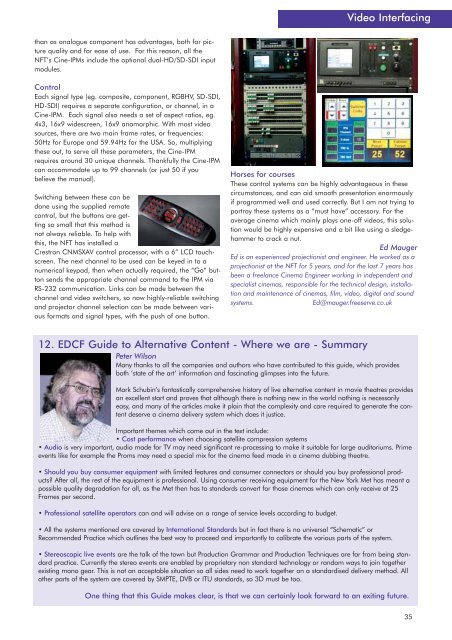The EDCF Guide to ALTERNATIVE CONTENT in Digital Cinema
The EDCF Guide to ALTERNATIVE CONTENT in Digital Cinema
The EDCF Guide to ALTERNATIVE CONTENT in Digital Cinema
Create successful ePaper yourself
Turn your PDF publications into a flip-book with our unique Google optimized e-Paper software.
than as analogue component has advantages, both for picture<br />
quality and for ease of use. For this reason, all the<br />
NFT’s C<strong>in</strong>e-IPMs <strong>in</strong>clude the optional dual-HD/SD-SDI <strong>in</strong>put<br />
modules.<br />
Control<br />
Each signal type (eg. composite, component, RGBHV, SD-SDI,<br />
HD-SDI) requires a separate configuration, or channel, <strong>in</strong> a<br />
C<strong>in</strong>e-IPM. Each signal also needs a set of aspect ratios, eg.<br />
4x3, 16x9 widescreen, 16x9 anamorphic. With most video<br />
sources, there are two ma<strong>in</strong> frame rates, or frequencies:<br />
50Hz for Europe and 59.94Hz for the USA. So, multiply<strong>in</strong>g<br />
these out, <strong>to</strong> serve all these parameters, the C<strong>in</strong>e-IPM<br />
requires around 30 unique channels. Thankfully the C<strong>in</strong>e-IPM<br />
can accommodate up <strong>to</strong> 99 channels (or just 50 if you<br />
believe the manual).<br />
Switch<strong>in</strong>g between these can be<br />
done us<strong>in</strong>g the supplied remote<br />
control, but the but<strong>to</strong>ns are gett<strong>in</strong>g<br />
so small that this method is<br />
not always reliable. To help with<br />
this, the NFT has <strong>in</strong>stalled a<br />
Crestron CNMSXAV control processor, with a 6” LCD <strong>to</strong>uchscreen.<br />
<strong>The</strong> next channel <strong>to</strong> be used can be keyed <strong>in</strong> <strong>to</strong> a<br />
numerical keypad, then when actually required, the “Go” but<strong>to</strong>n<br />
sends the appropriate channel command <strong>to</strong> the IPM via<br />
RS-232 communication. L<strong>in</strong>ks can be made between the<br />
channel and video switchers, so now highly-reliable switch<strong>in</strong>g<br />
and projec<strong>to</strong>r channel selection can be made between various<br />
formats and signal types, with the push of one but<strong>to</strong>n.<br />
Video Interfac<strong>in</strong>g<br />
Horses for courses<br />
<strong>The</strong>se control systems can be highly advantageous <strong>in</strong> these<br />
circumstances, and can aid smooth presentation enormously<br />
if programmed well and used correctly. But I am not try<strong>in</strong>g <strong>to</strong><br />
portray these systems as a “must have” accessory. For the<br />
average c<strong>in</strong>ema which ma<strong>in</strong>ly plays one-off videos, this solution<br />
would be highly expensive and a bit like us<strong>in</strong>g a sledgehammer<br />
<strong>to</strong> crack a nut.<br />
Ed Mauger<br />
Ed is an experienced projectionist and eng<strong>in</strong>eer. He worked as a<br />
projectionist at the NFT for 5 years, and for the last 7 years has<br />
been a freelance C<strong>in</strong>ema Eng<strong>in</strong>eer work<strong>in</strong>g <strong>in</strong> <strong>in</strong>dependent and<br />
specialist c<strong>in</strong>emas, responsible for the technical design, <strong>in</strong>stallation<br />
and ma<strong>in</strong>tenance of c<strong>in</strong>emas, film, video, digital and sound<br />
systems. Ed@mauger.freeserve.co.uk<br />
12. <strong>EDCF</strong> <strong>Guide</strong> <strong>to</strong> Alternative Content - Where we are - Summary<br />
Peter Wilson<br />
Many thanks <strong>to</strong> all the companies and authors who have contributed <strong>to</strong> this guide, which provides<br />
both ‘state of the art’ <strong>in</strong>formation and fasc<strong>in</strong>at<strong>in</strong>g glimpses <strong>in</strong><strong>to</strong> the future.<br />
Mark Schub<strong>in</strong>’s fantastically comprehensive his<strong>to</strong>ry of live alternative content <strong>in</strong> movie theatres provides<br />
an excellent start and proves that although there is noth<strong>in</strong>g new <strong>in</strong> the world noth<strong>in</strong>g is necessarily<br />
easy, and many of the articles make it pla<strong>in</strong> that the complexity and care required <strong>to</strong> generate the content<br />
deserve a c<strong>in</strong>ema delivery system which does it justice.<br />
Important themes which come out <strong>in</strong> the text <strong>in</strong>clude:<br />
• Cost performance when choos<strong>in</strong>g satellite compression systems<br />
• Audio is very important, audio made for TV may need significant re-process<strong>in</strong>g <strong>to</strong> make it suitable for large audi<strong>to</strong>riums. Prime<br />
events like for example the Proms may need a special mix for the c<strong>in</strong>ema feed made <strong>in</strong> a c<strong>in</strong>ema dubb<strong>in</strong>g theatre.<br />
• Should you buy consumer equipment with limited features and consumer connec<strong>to</strong>rs or should you buy professional products?<br />
After all, the rest of the equipment is professional. Us<strong>in</strong>g consumer receiv<strong>in</strong>g equipment for the New York Met has meant a<br />
possible quality degradation for all, as the Met then has <strong>to</strong> standards convert for those c<strong>in</strong>emas which can only receive at 25<br />
Frames per second.<br />
• Professional satellite opera<strong>to</strong>rs can and will advise on a range of service levels accord<strong>in</strong>g <strong>to</strong> budget.<br />
• All the systems mentioned are covered by International Standards but <strong>in</strong> fact there is no universal “Schematic” or<br />
Recommended Practice which outl<strong>in</strong>es the best way <strong>to</strong> proceed and importantly <strong>to</strong> calibrate the various parts of the system.<br />
• Stereoscopic live events are the talk of the <strong>to</strong>wn but Production Grammar and Production Techniques are far from be<strong>in</strong>g standard<br />
practice. Currently the stereo events are enabled by proprietary non standard technology or random ways <strong>to</strong> jo<strong>in</strong> <strong>to</strong>gether<br />
exist<strong>in</strong>g mono gear. This is not an acceptable situation so all sides need <strong>to</strong> work <strong>to</strong>gether on a standardised delivery method. All<br />
other parts of the system are covered by SMPTE, DVB or ITU standards, so 3D must be <strong>to</strong>o.<br />
One th<strong>in</strong>g that this <strong>Guide</strong> makes clear, is that we can certa<strong>in</strong>ly look forward <strong>to</strong> an exit<strong>in</strong>g future.<br />
35



